Numbers in Chinese
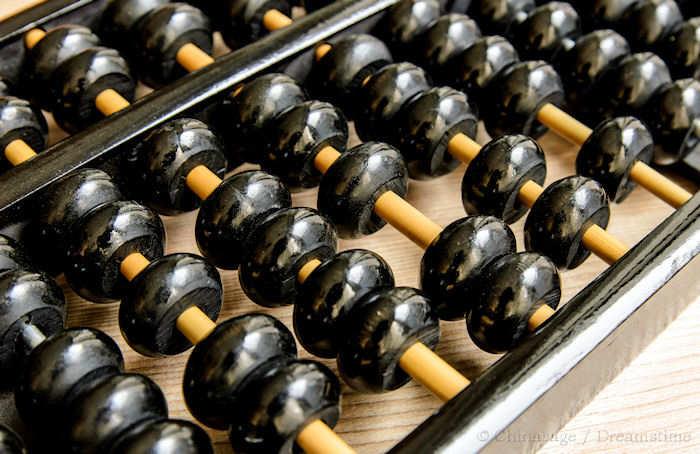
The systems of numbers in China is more straightforward than in other countries. From earliest times the decimal system has been used in China for counting and once you have mastered the numbers you can tell the date and time too. Nowadays the Arabic numbers (0 to 9) are often used when writing numbers. Here we give the history and symbolism associated with each of these numbers.
 Sounds like: 'ee' as in bee the 'y' is almost silent. (1st tone)
Sounds like: 'ee' as in bee the 'y' is almost silent. (1st tone)The number one is just one horizontal heng stroke. As in English, ‘one’ is used in many situations not just in counting, and is one of the most frequently occurring characters in text as in: Yidianr (a bit); Yihuir (a moment) Yixie (a little).
In spoken Chinese the alternative character 幺 yǎo can be used in place of yī. This is because, particularly on the phone the yī sound can be difficult to distinguish from qī and other characters.
 Tricky for English speakers as it is nothing like the word err and is closer to the sound of the word argh as in the exclamation Ooh Argh! (4th tone)
Tricky for English speakers as it is nothing like the word err and is closer to the sound of the word argh as in the exclamation Ooh Argh! (4th tone)An extra heng stroke added to 1 makes it 2.

In Chinese èr is used only in counting, the alternative 两 liǎng is used in other situations. This is like using pair or couple in English. Two, like all even numbers in China is considered a yin (female) number and associated with the earth. Two is a lucky number especially with regard to love and marriage. The yin-yang system is all about two contrasting alternatives.
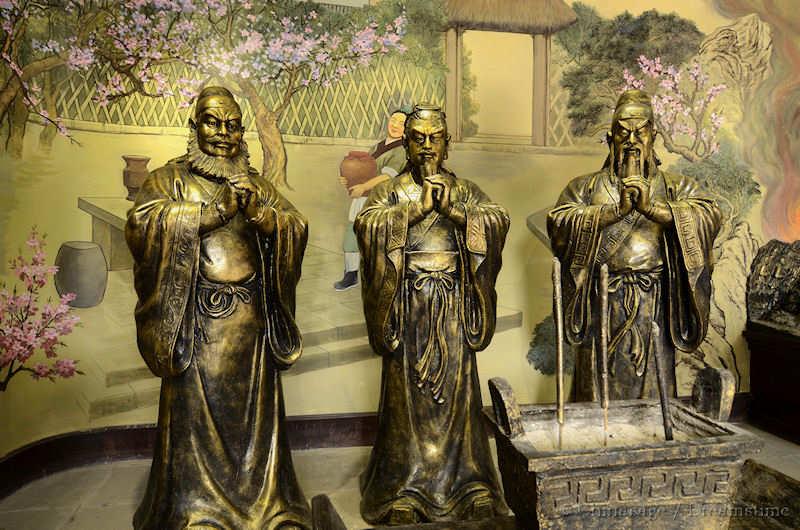
 Sounds like: ‘san’ in sanity (1st tone)
Sounds like: ‘san’ in sanity (1st tone)Another heng stroke adds 1 to two to make it three.
It is one of the luckiest numbers and is often found in phrases and slogans. In characters the same element repeated three times indicates very many as in 森 sēn forest made up of three 木 mù trees. Three represents the trinity of heaven, earth and man. The three main Chinese religions (Confucian, Daoist, Buddhist) each have 3 main teachings 三教 sān jiào. Buddhism has many trinities of objects: sayings and deities while Daoism has the trinity of Three Pure Ones. There are three friends of winter: pine, bamboo and plum as well as three lucky fruits or abundances: peach, pomegranate (sometimes lychee) and finger lemon. For centuries the San zi jing Three Character Classic was the first book children used to start writing Chinese, the lines all have 3 characters. The village elders were called the ‘Three old worthies’.
 Sounds like: a shortened form of sir rather than see but with a marked drop of tone. (4th tone)
Sounds like: a shortened form of sir rather than see but with a marked drop of tone. (4th tone)Adding another line would seem logical and the four bar representation was used in the early Shang dynasty written form. However, this does make the number prone to misreading so a different representation was created. The original design was a square area divided into four quarters, so now the character is a box with the character for division inside it.
Four is the most unlucky of Chinese numbers because the character 死 sǐ die; death only differs in tone to the character for 4. In her later years Dowager Empress Cixi forbade the saying of ‘si’ in her presence. Some roads have houses with no number 4 in them and some high-rise buildings have no 4th floor. It's also true that the 4th lunar month is one of the few without a festival.
China was traditionally considered to be enclosed by Four Seas (the earth was considered square with seas on all sides) and four Barbarian kingdoms. The four seasons are associated with four creatures, four directions and flowers : vermillion bird (plum- south), white tiger (orchid- west), azure dragon (bamboo- east) and black tortoise (chrysanthemum- north). In ancient times the traditional month was divided into 4 ten day weeks. There are four blessings 四福 sì fú: happiness, secure job, longevity and good luck. The four scholar's treasures are ink, paper, brush and ink-stone. The scholar engaged in four noble studies: music (especially the guqin), chess, painting and calligraphy. A Maoist campaign in the 1960s attacked the 4 olds ➚: ‘old culture, old customs, old habits and old thinking’.
 Sounds like: a bit like woo but with a drop in tone in the middle. (3rd tone)
Sounds like: a bit like woo but with a drop in tone in the middle. (3rd tone)The original form of the character five was clearer, as it showed a square with a center making a total of five points. The modern form is modified to show only the bottom left triangle of the square. Five is at the center of the Luo Shu magic square. The numbers 518 and 5189 are very lucky because the sequence sounds rather like ‘I will prosper’ and ‘I will prosper forever’ in Chinese
It is considered a yang number because it is an odd number. In China there are 5 directions rather than 4 (north, south, east, west and center). By tradition there are five elements and very many things are classified according to the governing element so there are five tastes, five smells, five classes of creature, five sacred mountains, five colors. There are five Classic books: Book of Documents, Book of Songs (or Odes), Book of Changes, Book of Rites and the Spring and Autumn Annals. There are also five blessings: long life, wealth, health, virtue and a peaceful death. Noxious creatures are also classed as a group of five: snake, toad, gecko, centipede and scorpion.
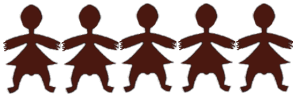
 Sounds like: the start of lieutenant. (Neutral tone)
Sounds like: the start of lieutenant. (Neutral tone)One way to remember how to write liu is that the character is rather like the Greek letter pi π with a dash on top, and two times pi is approximately six. Like the other even numbers sì (4) and bā (8) it includes a ‘cut’ stroke that indicates it can be divided in two.
Six has fewer cultural associations than the other numbers. Six was considered the 'lucky' number of the first Qin Emperor, and everything had to be in sixes – including the size of hats of the officials. It sounds a bit like 禄 lù meaning ‘prosperity’ and 流 liú meaning ‘flow’ so six of something can represent the wish for affairs to run smoothly. China was considered to have 6 great rivers. The ancient year of 360 days was split into 36 (6 x 6) ten day weeks. There are six emotions in three pairs: love & hate; anger & joy; pain & pleasure.
 Sounds like: 'tchee' as it needs a 't' sound which is not present in English 'ch'. (1st tone)
Sounds like: 'tchee' as it needs a 't' sound which is not present in English 'ch'. (1st tone)The character for seven looks like an upside down ‘continental ➚’ version of 7, making it easy to remember.
The seven stars in China may refer to sun, moon and the five major planets but also to the seven main stars of the Ursa Major ➚ (the Plow). The double seventh (Chinese Valentine's Day) festival is held on the seventh day of the seventh month. The old period of mourning was split up into 7 periods of 7 days. There are seven essentials for life: rice, oil, salt, soy sauce, vinegar, tea and firewood. The 7 day week was adopted in China in the Song dynasty, replacing the ancient ten day week.
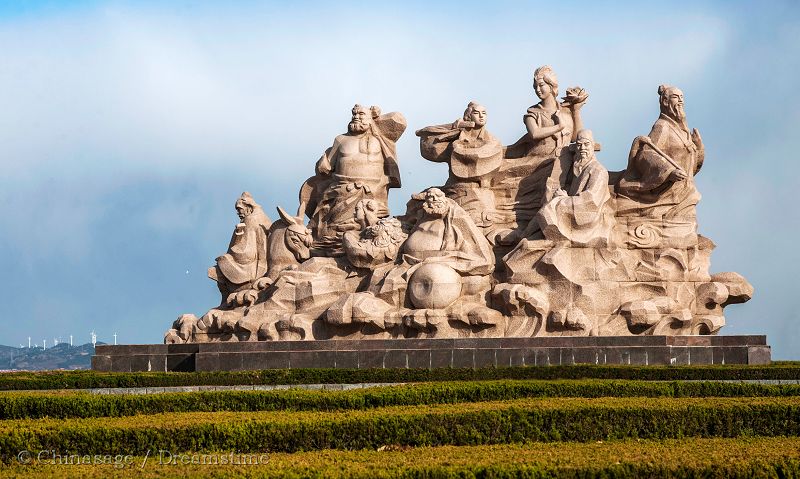
 Sounds like: bar (1st tone)
Sounds like: bar (1st tone)Eight is divisible by two and then by two again and so the representation shows division into two.
Eight is the most important yin number and occurs frequently in traditions. Earliest and most importantly there are 8 trigrams in the Yi Jing (I Ching WG) for foretelling the future, the association with eight then moved to the eight symbols of the eight Daoist Immortals (fan, sword, bottle-gourd, castanets, flower-basket, bamboo cane, flute and the lotus). Buddhists have their own selection of eight treasures (sea slug, umbrella, canopy, lotus, vase, fish, endless knot and the wheel of fortune). Buddhists also have an eightfold path to enlightenment: Correct understanding, correct thought, correct speech, correct action, correct livelihood, correct effort, correct mindfulness and correct concentration. Eight is the luckiest number and you often see it associated with gambling. There are many gambling web sites with 888 as part of the name (888sports, 888casino). The Beijing Olympics was opened on the 8/8/2008 at 8PM ➚. One reason for the luck may be the similarity in sound to 福 good fortune in Cantonese. Astrological readings use bazi 八字 eight characters that record the exact hour, day, month and year of conception. There are considered to be eight compass directions (N, NE, E, SE, S, SW, W and NW).
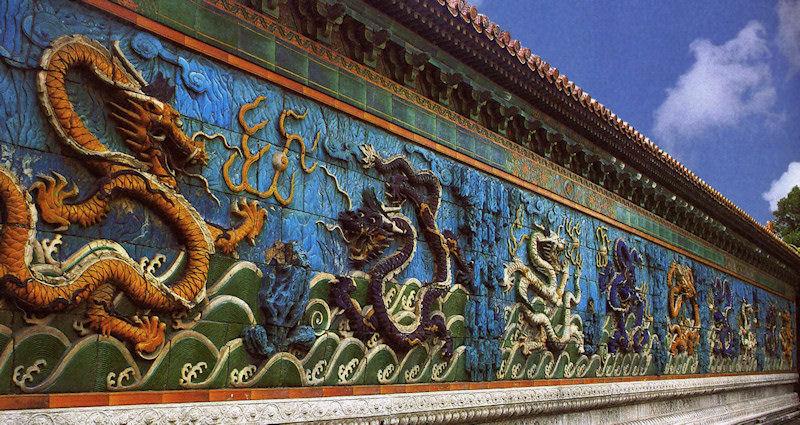
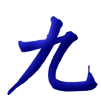 Sounds like: joe (3rd tone)
Sounds like: joe (3rd tone)The ‘iu’ sound is a bit confusing as it is tempting to read it as a ‘ew’ sound which is not correct. The pictograph may represent an object straining forward as if it is trying to reach the number ten; it looks a bit like the number ten with an extra stroke on the right.
As three is a yang number the square of 3, nine, is an very potent yang number. The ancient Book of Rites identifies nine rites (initiation of a boy, marriage, audience, embassy, burial, sacrifice, hospitality, toasting and military conflict). Land was traditionally split into nine plots and China was reputed to have been divided into nine provinces. The ancient regalia of the ‘Son of Heaven’ included nine bronze tripods (attributed to Yu the Great of the Xia dynasty) one for each ancient province. The Double Ninth Festival (Chongyang) takes place on the ninth day of the ninth month when it is traditional for people to walk to high ground and also fly kites.
The strong yang association of nine was used heavily in Imperial design, the Forbidden City was reputed to have 9,999 rooms and its large entrance doors are fitted with 9 rows of 9 columns of brass studs. There are 9 dragons on the Nine Dragon Wall in the Forbidden City and the Temple of Heaven has nine concentric rings each made up of a multiple of nine slabs. A dragon is considered to be a very yang creature made up of 9 parts and covered with 81 (9x9) scales. Beijing was designed as an area divided up by a grid of 9 north-south and 9 east-west avenues.
The sound of 九 jiǔ is the same as 久 jiǔ long time; long life which makes it a lucky number.
 Sounds like: start of sherlock (2nd tone)
Sounds like: start of sherlock (2nd tone)Looks like the Roman numeral ten (X) rotated. Shi is a very common Chinese sound, and even if you include the ones with the second pinyin tone there are still dozens of characters that sound just the same. It is a case where you may need to see the written character to be sure which one is meant. The very common character 是 shì (for is ; correct) differs only in tone from 十 shí so you have to be careful with pronunciation.
The symbol indicates completeness in height and width and is appropriate for the completion of the decimal span. The Ten Heavenly Stems (gan) formed an important part of Chinese calendars as together with the Twelve Earthly Branches it forms the traditional cycle of 60 years. An old legend is that the sky was illuminated by ten suns who were brothers, the great archer Hou Yi shot down nine of them so that the Earth could cool to a more tolerable temperature. There are traditionally ten symbols of longevity often found as art motifs: pine tree, sun, crane, water, mountains, clouds, deer, turtle, elixir of immortality and bamboo.
Ten to a hundred
The Chinese numbers between 10 and 100 are regular, unlike English and French (for example eighteen and soixante), there are no special new characters to learn. ‘Tens’ are followed by shí then the ‘units’. So forty five (45) is simply 四十五 sì shí wǔ and eighty-two (82) is 八十二 bā shí èr. If the number is a multiple of ten then no units are needed: so seventy (70) is simply 七十 qī shí
12
As elsewhere in the world a dozen is a popular number. It can be divided into 2, 3, 4 and 6 parts. There are 12 months in a normal year. From the Twelve Earthly Branches there are 12 years in the sequence of astrological sequence of animals. There are 12 symbols in the Imperial insignia.
13
The number 13 is considered unlucky in China, as in many other countries, this probably has its origin in the fact that the solar year divides into 12 and a bit lunar months. So this thirteenth ‘part’ month is a strange and inconvenient thing. The Chinese calendar inserts a whole extra thirteenth month every few years so a regular year has 12 months, the ‘unlucky’ intercalary month was called ‘Lord of Troubles’..
36
Thirty six was a significant number in China. The Qin Emperor's lucky, dynastic number was six and everything had to relate to six. Six times six (36) became an important number. His domain was reputed to laid out into 36 regions and there were 36 barbarian peoples beyond it.
 Sounds like: start of linger (2nd tone)
Sounds like: start of linger (2nd tone)A character for zero was not used for centuries, zero is not needed in counting or writing numbers as there is a character determining which is the unit (for example 三百 sān bǎi as 3 Hundreds rather than '3', '0', '0' 三零零 sān líng líng ). This is the same as in spoken English, it is only in written numeric form that a zero is needed. The character ling was introduced as the character for zero as a raindrop which is round like a zero and also had the meaning of last part. Qin Jiushao ➚ of the Song dynasty is considered the first to introduce zero into Chinese mathematics, some regard the lack of a zero as an obstacle to progress in early Chinese mathematics.
 Sounds like: bye (3rd tone)
Sounds like: bye (3rd tone)bǎi, one hundred, has the same sound as 白 bái clear, bright with the same tone. The written form has an extra heng stroke across the top to distinguish it.
The same logical progression applies to the numbers over 100, they have the number of hundreds followed by tens and then units. So 376 is 三百七十六 sān bǎi qī shí liù. However there is one exception to this regular pattern the numbers with no tens (101, 208, 502) have a special form using the character for zero 'ling' in the space for tens. So 504 is 五百零四 wǔ bǎi líng sì. Also the liang form of 2 may, sometimes, be used in the case of 200, 2,000 and 20,000 but not 20; so 200 can be expressed as 两百 liǎng bǎi
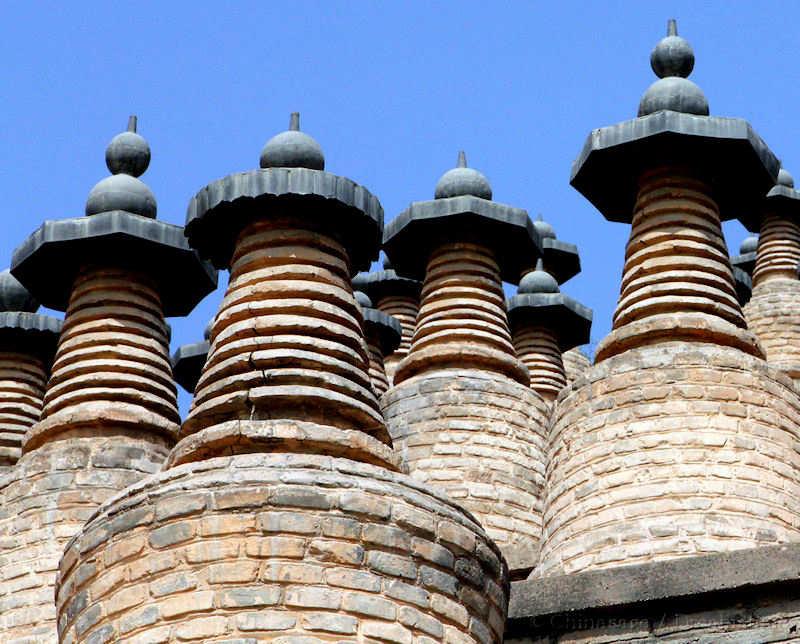
108 百零八 bǎi líng bā
For Buddhists in particular the number 108 has a great significance:
- Tài jí quán (Tai chi) has a complete set of 108 steps.
- The bells and drums at city centers were struck 108 times to indicate the start and end of the working day.
- The Manchu-Han Imperial Feast of the Qing dynasty had 108 dishes.
- To the south of Yinchuan in Ningxia there is an historic site with 108 dagobas.
- There are 108 beads on the Buddhist rosary worn around monk's necks. Bodhisattva Mahamati asked Buddha 108 questions.
- The Tang dynasty capital of Chang'an was divided into 108 wards.
- There are traditionally 108 Daoist masters.
- There are 108 ‘Stars of destiny’ (outlaws) in the classic book ‘The Water Margin’ by Shi Nai'an.
108 is chosen because it is a mathematically interesting number. It is the product of 1, 4 and 27 making it special as 11.22.33 defines it as the hyperfactorial ➚ of 3. In Chinese numerology the fundamental number of 108 is 9 as 1+0+8=9; and nine is the Imperial yang number. 108 is divisible by 2 , 3, 4, 6, 9, 12 and others making it a very useful number for counting such things as mantras. It can also be expressed as the sum of other significant numbers. 27 + 81 = 108 so it is considered a very yang number 27=3 x 3 x 3 and 81=3 x 3 x 3 x 3. In addition 36 + 72 = 108 so sixes (6 x 6) and (6 x 6 x 2) are also expressed. In the Chinese calendar there are 12 months and 24 solar mansions =36, there were 72 five day divisions of the ancient year (360 days).
Thousands in Chinese
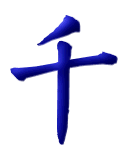 Sounds like: 'tchen' at the end of kitchen (1st tone)
Sounds like: 'tchen' at the end of kitchen (1st tone)A thousand has the form of ten with the addition of a dian stroke over it. The character is possibly derived from the combination of ten and person indicating ten lifetimes.
There is one new rule to apply, and that is that for numbers with two zeroes as in 2007, only one ‘ling’ is used for zero, it is not repeated: 二千零七 èr qiān líng qī. One of the three traditional language primers is the 1000 character classic with 1,000 different characters used only once; it is arranged in rhymes and used for calligraphy practice.
 Sounds like: won (4th tone)
Sounds like: won (4th tone)For centuries wan ten thousand was the largest numeric character in common usage and so is used in many idiomatic expressions for very many as in Wanli Changcheng for the Great Wall literally meaning countless mile fortress. In English, ‘million’ is often used in a similar way for an unbelievably large number such as one in a million chance or bet you a million dollars. Many translations translate wan literally as ten thousand when a term like infinite, countless, forever or myriad is more accurate. For example the proclamation May the Emperor live for ten thousand years really means May the Emperor live forever.
Coins used to be strung into groups of one hundred and so one hundred strings of cash was considered a fortune.
The character is 'borrowed' from a character that is pronounced the same way, in this case it is wan for scorpion 萬. The simplified written form threw away the scorpion association and chose a stylized form of the Indian good fortune symbol: the swastika 卍.
Large Numbers
The Chinese numbers above 10,000 use a different form, there is no special character for 100,000 and one million 1,000,000. Instead 100,000 is expressed as 10 x 10,000 十万 shí wàn and one million 1,000,000 as 100 x 10,000 一百万 yī bǎi wàn.
Following this logic 10,000,000 is 1,000 x 10,000 一千万 yī qiān wàn.
When 100,000,000 is reached a new character is available to represent 10,000 x 10,000 亿 yì. This yi (4th tone) only differs in tone from yī (1st tone) for one, This demonstrates rather forcibly how important tones are in Chinese, there is quite a bit of a difference between 1 and 100,000,000!
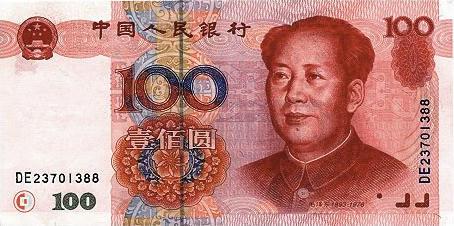
Chinese Bank notes
To counter the possibility of fraud by just adding an extra stroke or two to increase the written value, the numbers printed on bank notes and checks are given a different, more complex form. The Chinese introduced paper notes as long ago as the Tang dynasty (1,300 years ago). The more complex form for numbers is called 大写 dà xiě.
1:壹 2:贰 3:叁 4: 肆 5:伍 6: 陆 7: 柒 8:捌 9: 玖The decimal units also need different forms on notes to counter fraud. In some cases the simple form is a constituent of the more complex one.
0:零 10:拾 100:佰 1000:仟 10,000:萬 10,000,000:億Vocabulary
Now you have mastered numbers you can quickly read and tell the date and time. See Date and Time for all the details.
Sound files kindly provided by shtooka.net ➚ under a Creative Commons Attribution Share Alike License